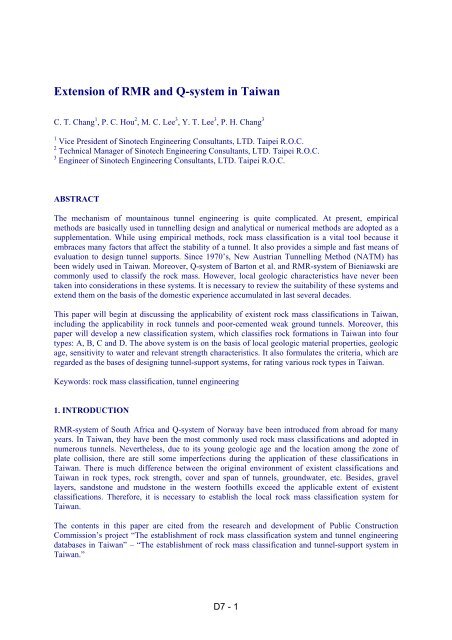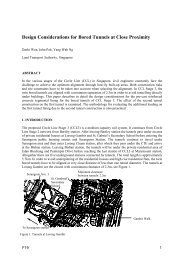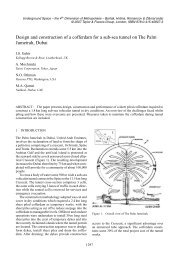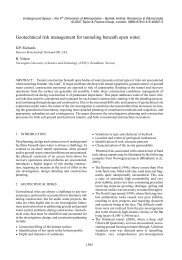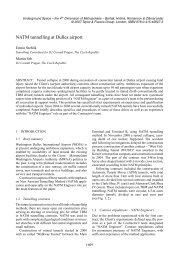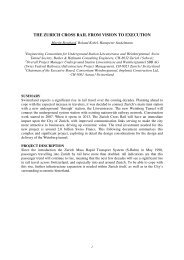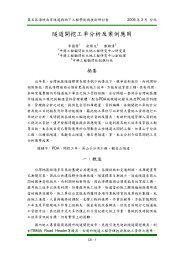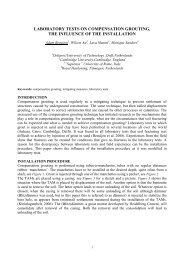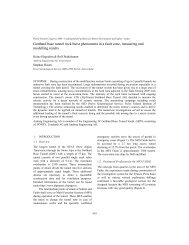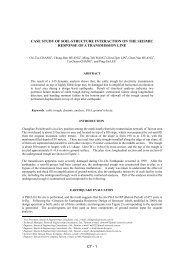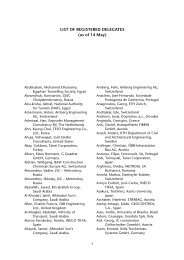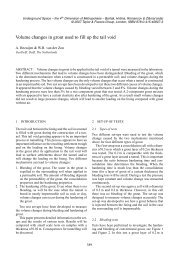Extension of RMR and Q-system in Taiwan
Extension of RMR and Q-system in Taiwan
Extension of RMR and Q-system in Taiwan
You also want an ePaper? Increase the reach of your titles
YUMPU automatically turns print PDFs into web optimized ePapers that Google loves.
<strong>Extension</strong> <strong>of</strong> <strong>RMR</strong> <strong>and</strong> Q-<strong>system</strong> <strong>in</strong> <strong>Taiwan</strong><br />
C. T. Chang 1 , P. C. Hou 2 , M. C. Lee 3 , Y. T. Lee 3 , P. H. Chang 3<br />
1 Vice President <strong>of</strong> S<strong>in</strong>otech Eng<strong>in</strong>eer<strong>in</strong>g Consultants, LTD. Taipei R.O.C.<br />
2 Technical Manager <strong>of</strong> S<strong>in</strong>otech Eng<strong>in</strong>eer<strong>in</strong>g Consultants, LTD. Taipei R.O.C.<br />
3 Eng<strong>in</strong>eer <strong>of</strong> S<strong>in</strong>otech Eng<strong>in</strong>eer<strong>in</strong>g Consultants, LTD. Taipei R.O.C.<br />
ABSTRACT<br />
The mechanism <strong>of</strong> mounta<strong>in</strong>ous tunnel eng<strong>in</strong>eer<strong>in</strong>g is quite complicated. At present, empirical<br />
methods are basically used <strong>in</strong> tunnell<strong>in</strong>g design <strong>and</strong> analytical or numerical methods are adopted as a<br />
supplementation. While us<strong>in</strong>g empirical methods, rock mass classification is a vital tool because it<br />
embraces many factors that affect the stability <strong>of</strong> a tunnel. It also provides a simple <strong>and</strong> fast means <strong>of</strong><br />
evaluation to design tunnel supports. S<strong>in</strong>ce 1970’s, New Austrian Tunnell<strong>in</strong>g Method (NATM) has<br />
been widely used <strong>in</strong> <strong>Taiwan</strong>. Moreover, Q-<strong>system</strong> <strong>of</strong> Barton et al. <strong>and</strong> <strong>RMR</strong>-<strong>system</strong> <strong>of</strong> Bieniawski are<br />
commonly used to classify the rock mass. However, local geologic characteristics have never been<br />
taken <strong>in</strong>to considerations <strong>in</strong> these <strong>system</strong>s. It is necessary to review the suitability <strong>of</strong> these <strong>system</strong>s <strong>and</strong><br />
extend them on the basis <strong>of</strong> the domestic experience accumulated <strong>in</strong> last several decades.<br />
This paper will beg<strong>in</strong> at discuss<strong>in</strong>g the applicability <strong>of</strong> existent rock mass classifications <strong>in</strong> <strong>Taiwan</strong>,<br />
<strong>in</strong>clud<strong>in</strong>g the applicability <strong>in</strong> rock tunnels <strong>and</strong> poor-cemented weak ground tunnels. Moreover, this<br />
paper will develop a new classification <strong>system</strong>, which classifies rock formations <strong>in</strong> <strong>Taiwan</strong> <strong>in</strong>to four<br />
types: A, B, C <strong>and</strong> D. The above <strong>system</strong> is on the basis <strong>of</strong> local geologic material properties, geologic<br />
age, sensitivity to water <strong>and</strong> relevant strength characteristics. It also formulates the criteria, which are<br />
regarded as the bases <strong>of</strong> design<strong>in</strong>g tunnel-support <strong>system</strong>s, for rat<strong>in</strong>g various rock types <strong>in</strong> <strong>Taiwan</strong>.<br />
Keywords: rock mass classification, tunnel eng<strong>in</strong>eer<strong>in</strong>g<br />
1. INTRODUCTION<br />
<strong>RMR</strong>-<strong>system</strong> <strong>of</strong> South Africa <strong>and</strong> Q-<strong>system</strong> <strong>of</strong> Norway have been <strong>in</strong>troduced from abroad for many<br />
years. In <strong>Taiwan</strong>, they have been the most commonly used rock mass classifications <strong>and</strong> adopted <strong>in</strong><br />
numerous tunnels. Nevertheless, due to its young geologic age <strong>and</strong> the location among the zone <strong>of</strong><br />
plate collision, there are still some imperfections dur<strong>in</strong>g the application <strong>of</strong> these classifications <strong>in</strong><br />
<strong>Taiwan</strong>. There is much difference between the orig<strong>in</strong>al environment <strong>of</strong> existent classifications <strong>and</strong><br />
<strong>Taiwan</strong> <strong>in</strong> rock types, rock strength, cover <strong>and</strong> span <strong>of</strong> tunnels, groundwater, etc. Besides, gravel<br />
layers, s<strong>and</strong>stone <strong>and</strong> mudstone <strong>in</strong> the western foothills exceed the applicable extent <strong>of</strong> existent<br />
classifications. Therefore, it is necessary to establish the local rock mass classification <strong>system</strong> for<br />
<strong>Taiwan</strong>.<br />
The contents <strong>in</strong> this paper are cited from the research <strong>and</strong> development <strong>of</strong> Public Construction<br />
Commission’s project “The establishment <strong>of</strong> rock mass classification <strong>system</strong> <strong>and</strong> tunnel eng<strong>in</strong>eer<strong>in</strong>g<br />
databases <strong>in</strong> <strong>Taiwan</strong>” – “The establishment <strong>of</strong> rock mass classification <strong>and</strong> tunnel-support <strong>system</strong> <strong>in</strong><br />
<strong>Taiwan</strong>.”<br />
D7 - 1
2. THE APPLICATION OF EXISTENT ROCK MASS CLASSIFICATION SYSTEMS<br />
By mak<strong>in</strong>g a comprehensive survey <strong>of</strong> major rock mass classifications worldwide, it can be traced<br />
back to the middle <strong>of</strong> 1940’s that Terzaghi proposed the rock load method. Nevertheless, <strong>in</strong> <strong>Taiwan</strong>,<br />
rock mass classifications weren’t adopted to design tunnel supports until late 1950’s. The above<br />
method was ma<strong>in</strong>ly used at that period <strong>of</strong> time <strong>and</strong> it could classify the rock mass around tunnels <strong>in</strong>to<br />
n<strong>in</strong>e rock load classes by us<strong>in</strong>g qualitative method. And it could be possible to design the so-called<br />
rigid support <strong>system</strong> by us<strong>in</strong>g the conventional, semi-empirical, <strong>and</strong> structural analysis model. General<br />
speak<strong>in</strong>g, rock load method is more suitable for shallow cover tunnels. As our underst<strong>and</strong><strong>in</strong>g <strong>of</strong><br />
tunnell<strong>in</strong>g behavior improved, the construction concept <strong>of</strong> NATM was <strong>in</strong>troduced <strong>in</strong>to <strong>Taiwan</strong> <strong>in</strong> late<br />
1970’s <strong>and</strong> has become the ma<strong>in</strong>stream nowadays.<br />
Rock mass classification <strong>system</strong>s adopted <strong>in</strong> mounta<strong>in</strong>ous tunnel eng<strong>in</strong>eer<strong>in</strong>g <strong>in</strong> <strong>Taiwan</strong> can be<br />
roughly divided <strong>in</strong>to two groups: qualitative <strong>and</strong> quantitative. For qualitative methods, rock load<br />
method <strong>of</strong> Terzaghi <strong>and</strong> rock mass classification <strong>of</strong> Austrian are the common ones; while the <strong>RMR</strong><strong>system</strong><br />
<strong>and</strong> Q-<strong>system</strong> are ma<strong>in</strong>stream for quantitative methods. Nevertheless, the rock mass<br />
classifications or classes nowadays used <strong>in</strong> <strong>Taiwan</strong> are quite different from the orig<strong>in</strong>al <strong>system</strong><br />
because <strong>of</strong> technological <strong>in</strong>novation <strong>and</strong> accumulated experience these years. Take the correspond<strong>in</strong>g<br />
<strong>RMR</strong> rat<strong>in</strong>g <strong>of</strong> the third rock mass class for <strong>in</strong>stance: Mu-Zha Tunnel <strong>of</strong> Northern Second Freeway is<br />
56~65 <strong>and</strong> new water channel <strong>of</strong> Wu-Jie is 44~56. Those were both not the proposed value <strong>of</strong> <strong>RMR</strong><strong>system</strong><br />
as 40~60. Besides, the rock mass classes adopted <strong>in</strong> tunnel groups <strong>of</strong> Northern Second<br />
Freeway had <strong>in</strong>creased by five classes to six. (Class I ~ Class VI)<br />
Furthermore, as the economical development grows up <strong>in</strong> <strong>Taiwan</strong> these years, the cases <strong>of</strong> tunnels<br />
along the western foothills <strong>in</strong>crease. For example, Lan-Tan Tunnel <strong>and</strong> Zhong-Liao Tunnel <strong>of</strong><br />
Southern Second Freeway, Pakuashan Tunnel <strong>of</strong> Hanbao-Tsaotuen Expressway, tunnel groups <strong>of</strong><br />
High Speed Railway Project, etc. were all constructed along this area. The rock formations <strong>of</strong> this area<br />
are chiefly composed <strong>of</strong> gravel layers, s<strong>and</strong>stone, <strong>and</strong> mudstone. As a result <strong>of</strong> uncompleted<br />
lithification <strong>and</strong> geologic material compositions, there are usually some characteristics <strong>in</strong> this k<strong>in</strong>d <strong>of</strong><br />
formation such as: (a) the ground is approximately <strong>in</strong>tact <strong>and</strong> has few jo<strong>in</strong>ts, (b) the strength <strong>of</strong> this<br />
ground tends to be lower, (c) weaken easily with <strong>in</strong>filtration by water. Therefore, it is unsuitable to<br />
adopt <strong>RMR</strong>-<strong>system</strong> <strong>and</strong> Q-<strong>system</strong>, which lay great emphasis on weak planes <strong>of</strong> rock mass structures,<br />
to classify the above formation. At present <strong>in</strong> <strong>Taiwan</strong>, qualitative rock mass classification <strong>system</strong>s are<br />
<strong>of</strong>ten used to classify this formation <strong>and</strong> the result <strong>of</strong> execution is quite good <strong>in</strong> general. However, the<br />
geologic material properties encountered <strong>in</strong> tunnels differ from case by case <strong>and</strong> the classification<br />
can’t always be adopted with each other.<br />
3. THE ESTABLISHMENT OF THE ROCK MASS CLASSIFICATION SYSTEM IN TAIWAN<br />
3.1 Considered factors <strong>of</strong> the skeleton<br />
Accord<strong>in</strong>g to the application <strong>of</strong> existent rock mass classification <strong>system</strong>s <strong>in</strong> <strong>Taiwan</strong>, the skeleton <strong>and</strong><br />
considered reasons <strong>of</strong> the rock mass classification <strong>system</strong> <strong>in</strong> <strong>Taiwan</strong> are described as follows:<br />
(1) At present <strong>in</strong> <strong>Taiwan</strong>, quantitative classifications such as <strong>RMR</strong>-<strong>system</strong> <strong>and</strong> Q-<strong>system</strong> are generally<br />
used while qualitative methods are adopted <strong>in</strong> the gravel layers, s<strong>and</strong>stone <strong>and</strong> mudstone. The<br />
skeleton <strong>of</strong> the rock mass classification <strong>system</strong> <strong>in</strong> <strong>Taiwan</strong> is established by follow<strong>in</strong>g the above<br />
concept. In addition, because the <strong>in</strong>fluence <strong>of</strong> cover differs from case by case, this factor is not<br />
embraced as the evaluation factor <strong>and</strong> will be properly considered <strong>in</strong> the tunnel-support suggestion<br />
if it is necessary.<br />
D7 - 2
(2) For quantitative classifications, with comparison between <strong>RMR</strong>-<strong>system</strong> <strong>and</strong> Q-<strong>system</strong>, it is simpler<br />
to evaluate <strong>and</strong> calculate by us<strong>in</strong>g <strong>RMR</strong>-<strong>system</strong>. Moreover, while different people evaluate the<br />
same rock mass, there is less difference by us<strong>in</strong>g <strong>RMR</strong>-<strong>system</strong> <strong>in</strong> general. Therefore, the rock mass<br />
classification <strong>system</strong> <strong>in</strong> <strong>Taiwan</strong> is ma<strong>in</strong>ly on the basis <strong>of</strong> <strong>RMR</strong>-<strong>system</strong> <strong>and</strong> takes Q-<strong>system</strong> as a<br />
complementary approach.<br />
(3) The selection <strong>of</strong> quantitative or qualitative classifications is based on the geologic material<br />
properties encountered <strong>in</strong> tunnels. Consequently, bas<strong>in</strong>g on the geologic material properties first<br />
<strong>and</strong> then with reference to geologic age <strong>and</strong> relevant strength parameters, we classified the<br />
geologic formations <strong>in</strong> <strong>Taiwan</strong> <strong>in</strong>to different rock types. The purpose is to dist<strong>in</strong>guish those rock<br />
formations, which are suitable for quantitative classifications or qualitative ones. Rock mass<br />
classes <strong>of</strong> various rock types can be decided by quantitative or qualitative rock mass rat<strong>in</strong>g method.<br />
(4) The above rock mass classification <strong>and</strong> rat<strong>in</strong>g method, based on the consideration <strong>of</strong> geologic<br />
factors, can be applied <strong>in</strong> tunnels such as highways, railways, <strong>and</strong> water resource tunnels <strong>in</strong><br />
<strong>Taiwan</strong> <strong>in</strong> the future. In addition, accord<strong>in</strong>g to the rat<strong>in</strong>g <strong>of</strong> rock mass along the tunnel, we can<br />
design tunnel supports with consideration <strong>of</strong> the span, cover, <strong>and</strong> other eng<strong>in</strong>eer<strong>in</strong>g factors<br />
simultaneously <strong>in</strong> that case.<br />
(5) Due to the special geologic background, tunnel eng<strong>in</strong>eer<strong>in</strong>g <strong>in</strong> <strong>Taiwan</strong> have encountered special<br />
geologic condition several times <strong>in</strong> past twenty years such as faults, water egression, squeez<strong>in</strong>g,<br />
swell<strong>in</strong>g, high tendency to rock burst, high ground temperature <strong>and</strong> hazardous gas. The<br />
applicability <strong>of</strong> existent rock mass classifications under above conditions is frequently doubted. By<br />
evaluat<strong>in</strong>g these special geologic conditions encountered <strong>in</strong> tunnels, we suppose it is impossible to<br />
be solved basically by rock mass classifications. It is necessary to develop special correspond<strong>in</strong>g<br />
excavation technology <strong>and</strong> tunnel-support <strong>system</strong>s. Consequently, the rock mass classification<br />
<strong>system</strong> <strong>in</strong> <strong>Taiwan</strong> proposed <strong>in</strong> this paper is suitable for rock mass <strong>in</strong> general condition, exclusive <strong>of</strong><br />
special geologic conditions. In the case <strong>of</strong> special geologic conditions, it is necessary to consider<br />
especially about the excavation technology <strong>and</strong> support design because they differ from case by<br />
case.<br />
3.2 The establishment <strong>of</strong> the classification <strong>system</strong><br />
3.2.1 Pr<strong>in</strong>ciples <strong>of</strong> the rock mass classification<br />
Accord<strong>in</strong>g to the skeleton <strong>of</strong> the rock mass classification mentioned <strong>in</strong> the previous section, first <strong>of</strong> all<br />
we classify all the geologic formations <strong>in</strong> <strong>Taiwan</strong> <strong>in</strong>to different rock types. The purpose is to<br />
dist<strong>in</strong>guish those formations, which are suitable for quantitative or qualitative classifications.<br />
General speak<strong>in</strong>g, without the consideration <strong>of</strong> faults, fold structures <strong>and</strong> weather<strong>in</strong>g, it is possible to<br />
estimate the rock properties, strength <strong>and</strong> other eng<strong>in</strong>eer<strong>in</strong>g geologic characteristics <strong>of</strong> a s<strong>in</strong>gle layer.<br />
Therefore, under the condition for lack <strong>of</strong> detailed geologic <strong>in</strong>vestigation <strong>and</strong> experimental data <strong>in</strong> the<br />
plan stage, the strata along the tunnel may be the only geologic <strong>in</strong>formation by data collect<strong>in</strong>g <strong>in</strong><br />
advance. Consequently, stratum is the basic unit to classify rock types while utilis<strong>in</strong>g our classification<br />
<strong>system</strong>.<br />
Rock mechanics experimental data <strong>of</strong> important public eng<strong>in</strong>eer<strong>in</strong>g cases <strong>in</strong> <strong>Taiwan</strong> have been<br />
collected. (2230 sets <strong>of</strong> uniaxial compression test <strong>and</strong> 250 sets <strong>of</strong> triaxial compression test are <strong>in</strong>cluded)<br />
By review<strong>in</strong>g the rock mechanics properties <strong>of</strong> strata <strong>in</strong> <strong>Taiwan</strong> <strong>and</strong> furthermore with reference to<br />
geologic age, geologic material formation, characteristics <strong>of</strong> weak plane <strong>in</strong> rock mass, etc., the strata <strong>in</strong><br />
<strong>Taiwan</strong> can be classified <strong>in</strong>to A, B, C, <strong>and</strong> D four rock types. The distribution <strong>of</strong> these four rock types<br />
<strong>in</strong> <strong>Taiwan</strong> is shown as Fig.3-1. The pr<strong>in</strong>ciples <strong>of</strong> classification are mentioned as follows:<br />
D7 - 3
Ma-Zu Area<br />
J<strong>in</strong>-Men Area<br />
Rock Type A<br />
Rock Type B<br />
Rock Type C<br />
Rock Type D<br />
Fig.3-1 The Distribution <strong>of</strong> Rock Type A, B, C <strong>and</strong> D <strong>in</strong> <strong>Taiwan</strong><br />
D7 - 4
(1) Rock Type A: The strength <strong>of</strong> this type can be approximately corresponded to higher or equal to<br />
“moderate strength” <strong>in</strong> the geologic material strength rat<strong>in</strong>g <strong>of</strong> ISRM. This rock type is hard <strong>and</strong><br />
brittle. Due to tectonic stress, jo<strong>in</strong>ts are easy to be developed <strong>in</strong> this type. The failure mechanism<br />
<strong>of</strong> this rock type is structural failure controlled by weak planes such as jo<strong>in</strong>ts <strong>and</strong> cleavage. In<br />
<strong>Taiwan</strong>, all metamorphic rocks, sub-metamorphic rocks, igneous rocks, exclusive <strong>of</strong> volcanic<br />
breccia, <strong>and</strong> sedimentary rock, whose degree <strong>of</strong> lithification <strong>and</strong> strength is high, are all <strong>in</strong>cluded<br />
<strong>in</strong> this rock type.<br />
(2) Rock Type B: The strength <strong>of</strong> this type can be approximately corresponded to “low strength” <strong>in</strong><br />
the geologic material strength rat<strong>in</strong>g <strong>of</strong> ISRM. This rock type isn’t as hard <strong>and</strong> brittle as Rock<br />
Type A. Under tectonic stress, jo<strong>in</strong>ts aren’t easy to be developed <strong>in</strong> this type. Because <strong>of</strong> poor<br />
cementation, the strength will decrease significantly as the water content goes up. The failure<br />
mechanism <strong>of</strong> this rock type <strong>in</strong>cludes structural <strong>and</strong> material failure. In <strong>Taiwan</strong>, sedimentary rocks,<br />
which are cemented but weaker <strong>and</strong> <strong>of</strong>ten distributed along the western foothills, are <strong>in</strong>cluded <strong>in</strong><br />
this rock type.<br />
(3) Rock Type C: The strength <strong>of</strong> this type can be approximately corresponded to lower or equal to<br />
“very low strength” <strong>in</strong> the geologic material strength rat<strong>in</strong>g <strong>of</strong> ISRM. Besides, this rock type also<br />
embraced complex materials, whose mechanics behavior is controlled by f<strong>in</strong>e gra<strong>in</strong>s <strong>and</strong> the<br />
content <strong>of</strong> coarse gra<strong>in</strong>s (gra<strong>in</strong> size greater than sieve #4) is less than 50%. The degree <strong>of</strong><br />
cementation is extremely poorer than Rock Type A <strong>and</strong> B. The phenomenon <strong>of</strong> s<strong>of</strong>ten<strong>in</strong>g is quite<br />
obvious with <strong>in</strong>filtration by water. There are few geologic weak planes <strong>in</strong> this rock type. The<br />
failure mechanism is chiefly material failure. The determ<strong>in</strong>ate factor <strong>of</strong> rock mass strength is<br />
ma<strong>in</strong>ly the properties <strong>of</strong> compositions, cementation <strong>and</strong> water content. The strata <strong>of</strong> late Pliocene<br />
to Pleistocene <strong>in</strong> the south <strong>of</strong> <strong>Taiwan</strong>, <strong>and</strong> the poor-cemented sedimentary rocks or melanges <strong>in</strong> the<br />
Eastern Coastal Mounta<strong>in</strong> are <strong>in</strong>cluded <strong>in</strong> this rock type.<br />
(4) Rock Type D: This rock type is roughly supposed to be complex materials with f<strong>in</strong>e gra<strong>in</strong>s. It is<br />
ma<strong>in</strong>ly composed <strong>of</strong> coarse gra<strong>in</strong>s (the content is greater than 50%). Gravel layers, volcanic<br />
breccia, volcanic agglomerate, etc. are <strong>in</strong>cluded <strong>in</strong> this rock type. The variation <strong>of</strong> uniaxial<br />
compression strength is considerable <strong>and</strong> it results <strong>in</strong> the amounts <strong>of</strong> weak planes. Moreover, the<br />
rock mass strength, which is <strong>in</strong>fluenced by the amounts <strong>of</strong> water content, varies from case by case.<br />
The failure mechanism <strong>of</strong> rock mass is ma<strong>in</strong>ly controlled by the cementation <strong>of</strong> f<strong>in</strong>e gra<strong>in</strong>s while<br />
the content <strong>of</strong> coarse gra<strong>in</strong>s is between 50% to 75%; the failure mechanism <strong>of</strong> rock mass is ma<strong>in</strong>ly<br />
controlled by the coarse gra<strong>in</strong>s while the content <strong>of</strong> coarse gra<strong>in</strong>s is greater than 75%.<br />
3.2.2 Criteria <strong>of</strong> rock mass rat<strong>in</strong>g<br />
Quantitative rat<strong>in</strong>g criteria <strong>of</strong> <strong>RMR</strong>-<strong>system</strong> is proposed to rate the rock mass belongs to Rock Type A<br />
<strong>and</strong> B. Furthermore, bas<strong>in</strong>g on the <strong>RMR</strong> rat<strong>in</strong>g, rock mass can be rated <strong>in</strong>to different rock mass classes.<br />
(Shown as Table 3-1) On the other h<strong>and</strong>, we propose to adopt qualitative rat<strong>in</strong>g criteria composed <strong>of</strong><br />
geologic compositions, the ratio <strong>of</strong> coarse gra<strong>in</strong>s, cementation <strong>and</strong> other characteristics to rate the rock<br />
mass belongs to Rock Type C <strong>and</strong> D. (Shown as Table 3-2)<br />
D7 - 5
Table 3-1 Criteria for rat<strong>in</strong>g Rock Type A <strong>and</strong> B<br />
Rock mass class <strong>of</strong><br />
Rock Type A<br />
<strong>RMR</strong> range <strong>of</strong><br />
Rock Type A<br />
<strong>RMR</strong> range <strong>of</strong><br />
Rock Type B<br />
Rock mass class <strong>of</strong><br />
Rock Type B<br />
AⅠ <strong>RMR</strong>≧81 ---- ----<br />
AⅡ <strong>RMR</strong>80~61 <strong>RMR</strong>≧81 BⅡ<br />
AⅢ <strong>RMR</strong>60~41 <strong>RMR</strong>80~61 BⅢ<br />
AⅣ <strong>RMR</strong>40~21 <strong>RMR</strong>60~41 BⅣ<br />
AⅤ <strong>RMR</strong>20~11 <strong>RMR</strong>40~21 BⅤ<br />
AⅥ <strong>RMR</strong>≦10 <strong>RMR</strong>≦20 BⅥ<br />
Table 3-2 Criteria for rat<strong>in</strong>g Rock Type C <strong>and</strong> D<br />
Rock mass class<br />
Cementation<br />
St<strong>and</strong>ards <strong>of</strong> rat<strong>in</strong>g<br />
Geologic material composition<br />
Rock<br />
Type<br />
CⅠ(C)<br />
CⅠ(MIX)<br />
CⅠ(S)<br />
Fair or good cementation<br />
(can’t be dented by the thumb)<br />
The content <strong>of</strong> silt <strong>and</strong> clay is greater than 50%<br />
The content <strong>of</strong> s<strong>and</strong>, silt, clay or gravel<br />
<strong>in</strong>dividually isn’t greater than 50%<br />
The content <strong>of</strong> s<strong>and</strong> is greater than 50%<br />
C<br />
CⅡ(C)<br />
Poor or loose cementation<br />
CⅡ(MIX)<br />
(can be dented by the thumb)<br />
The content <strong>of</strong> silt <strong>and</strong> clay is greater than 50%<br />
The content <strong>of</strong> s<strong>and</strong>, silt, clay or gravel<br />
<strong>in</strong>dividually isn’t greater than 50%<br />
CⅡ(S)<br />
The content <strong>of</strong> s<strong>and</strong> is greater than 50%<br />
The content <strong>of</strong> boulders <strong>and</strong> coarse gra<strong>in</strong>s (gra<strong>in</strong><br />
DⅠ(G) Extremely good cementation size greater than sieve #4) is greater than 75 %;<br />
(boulders or gravel need to be contact with each other<br />
knocked <strong>of</strong>f by geologic hammer The content <strong>of</strong> boulders <strong>and</strong> coarse gra<strong>in</strong>s (gra<strong>in</strong><br />
DⅠ(M) with great power)<br />
size greater than sieve #4) is between 50% ~<br />
75%; don’t contact with each other<br />
The content <strong>of</strong> boulders <strong>and</strong> coarse gra<strong>in</strong>s (gra<strong>in</strong><br />
Rock<br />
Type<br />
D<br />
DⅡ(G)<br />
DⅡ(M)<br />
size greater than sieve #4) is greater than 75 %;<br />
Fair or good cementation<br />
contact with each other<br />
(boulders or gravel need to be<br />
knocked <strong>of</strong>f by geologic hammer)<br />
The content <strong>of</strong> boulders <strong>and</strong> coarse gra<strong>in</strong>s (gra<strong>in</strong><br />
size greater than sieve #4) is between 50% ~<br />
75%; don’t contact with each other<br />
The content <strong>of</strong> boulders <strong>and</strong> coarse gra<strong>in</strong>s (gra<strong>in</strong><br />
DⅢ(G)<br />
DⅢ(M)<br />
Poor or loose cementation<br />
(boulders or gravel need to be<br />
knocked <strong>of</strong>f by h<strong>and</strong>)<br />
size greater than sieve #4) is greater than 75 %;<br />
contact with each other<br />
The content <strong>of</strong> boulders <strong>and</strong> coarse gra<strong>in</strong>s (gra<strong>in</strong><br />
size greater than sieve #4) is between 50% ~<br />
75%; don’t contact with each other<br />
Notes: 1.Because the amount <strong>of</strong> water content affects the tunnel construction <strong>of</strong> Rock Type C <strong>and</strong> D<br />
considerably, this table must be adopted based on dra<strong>in</strong>age <strong>in</strong> advance.<br />
2.S<strong>and</strong> layers <strong>and</strong> gravel layers possibly appear simultaneously on the excavation face. The<br />
location <strong>of</strong> s<strong>and</strong> layers on the excavation face has a determ<strong>in</strong>ate <strong>in</strong>fluence on the stability <strong>of</strong><br />
tunnels, <strong>and</strong> it should be considered carefully while design<strong>in</strong>g tunnel supports.<br />
D7 - 6
4. CONCLUSION<br />
The establishment <strong>of</strong> the rock mass classification <strong>system</strong> <strong>in</strong> <strong>Taiwan</strong> is based on the design <strong>and</strong><br />
construction experience accumulated <strong>in</strong> past twenty years <strong>in</strong> <strong>Taiwan</strong> <strong>and</strong> moreover with consideration<br />
<strong>of</strong> local geologic age, geologic structures, rock mass strength, the <strong>in</strong>fluence <strong>of</strong> groundwater <strong>in</strong> rock<br />
mass, compositions <strong>of</strong> rock layers, etc. In the future, this <strong>system</strong> can be adopted <strong>in</strong> tunnel eng<strong>in</strong>eer<strong>in</strong>g<br />
at the plan <strong>and</strong> design stage. Accord<strong>in</strong>g to the strata along the tunnel, rock mass can rapidly be<br />
classified <strong>in</strong>to Rock Type A, B, C or D. Furthermore, the correspond<strong>in</strong>g rock mass rat<strong>in</strong>g criteria to<br />
execute the rat<strong>in</strong>g task can be chosen. Bas<strong>in</strong>g on the above results, we can design tunnel supports. It is<br />
equal to say that this rock mass classification <strong>system</strong> can be regarded as the bases <strong>of</strong> rock mass<br />
characteristic evaluation <strong>and</strong> tunnel-support design.<br />
ACKNOWLEDGEMENT<br />
We would like to express our thanks to Public Construction Commission, Executive Yuan, which<br />
supports the expenditure <strong>of</strong> this project. On-site verification was assisted by Directorate General <strong>of</strong><br />
Highways, MOTC, Water Resources Agency, M<strong>in</strong>istry <strong>of</strong> Economic Affairs, <strong>Taiwan</strong> Power Company,<br />
Eng<strong>in</strong>eer<strong>in</strong>g Department <strong>of</strong> High Speed Rail System <strong>of</strong> Transportation Bureau, <strong>Taiwan</strong> Area National<br />
Expressway Eng<strong>in</strong>eer<strong>in</strong>g Bureau, MOTC, Eastern Eng<strong>in</strong>eer<strong>in</strong>g Department <strong>of</strong> Railway Reconstruction<br />
Bureau, etc. Furthermore, this project is also <strong>in</strong> co-operation with United Geotech, Inc., Ch<strong>in</strong>a<br />
Eng<strong>in</strong>eer<strong>in</strong>g Consultants, Inc., Moh <strong>and</strong> Associates, Inc., S<strong>in</strong>otech Eng<strong>in</strong>eer<strong>in</strong>g Consultants, Inc.,<br />
National <strong>Taiwan</strong> University, National Central University, National <strong>Taiwan</strong> University <strong>of</strong> Science &<br />
Technology, National Taipei University <strong>of</strong> Technology, etc. In addition, this project has been<br />
exam<strong>in</strong>ed several times by consultants <strong>in</strong>vited by Public Construction Commission, Executive Yuan,<br />
for example, J. J. Hung, C. H. Huang, J. Z. Lee, Z. X. Ye, Y. S. Xie, N. H. Huang et al. They also<br />
provided many treasured suggestions.<br />
REFERENCE<br />
1.C. T. Chang, W. T. Wang, L. Z. Sun, N. H. Huang et al., 2000. The establishment <strong>of</strong> rock mass<br />
classification <strong>system</strong> <strong>and</strong> tunnel eng<strong>in</strong>eer<strong>in</strong>g databases <strong>in</strong> <strong>Taiwan</strong> (Phase 1) – Work Item D: The<br />
establishment <strong>of</strong> rock mass classification <strong>and</strong> tunnel-support <strong>system</strong> <strong>in</strong> <strong>Taiwan</strong>, Public Construction<br />
Commission, Executive Yuan.<br />
2.C. T. Chang, M. L. L<strong>in</strong>, L. Z. Sun et al., 2001. The establishment <strong>of</strong> rock mass classification <strong>system</strong><br />
<strong>and</strong> tunnel eng<strong>in</strong>eer<strong>in</strong>g databases <strong>in</strong> <strong>Taiwan</strong> (Phase 2) – Work Item D: The establishment <strong>of</strong> rock mass<br />
classification <strong>and</strong> tunnel-support <strong>system</strong> <strong>in</strong> <strong>Taiwan</strong>, Public Construction Commission, Executive Yuan.<br />
3.C. T. Chang, P. C. Hou, M. C. Lee et al., 2002. The establishment <strong>of</strong> rock mass classification <strong>system</strong><br />
<strong>and</strong> tunnel eng<strong>in</strong>eer<strong>in</strong>g databases <strong>in</strong> <strong>Taiwan</strong> (Phase 3) – Work Item D: The establishment <strong>of</strong> rock mass<br />
classification <strong>and</strong> tunnel-support <strong>system</strong> <strong>in</strong> <strong>Taiwan</strong>, Public Construction Commission, Executive Yuan.<br />
D7 - 7


